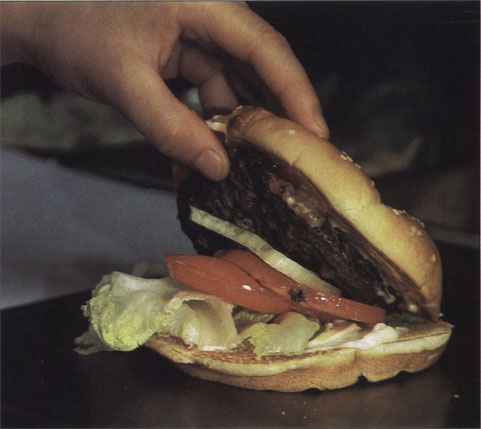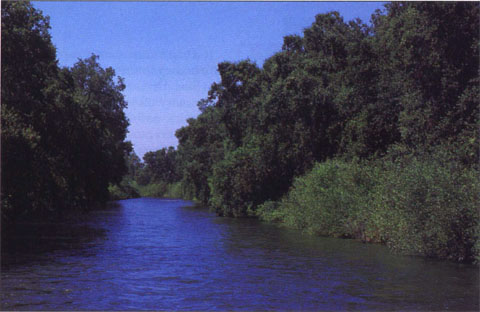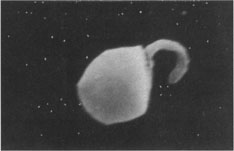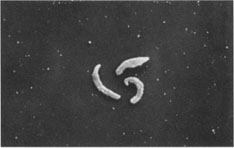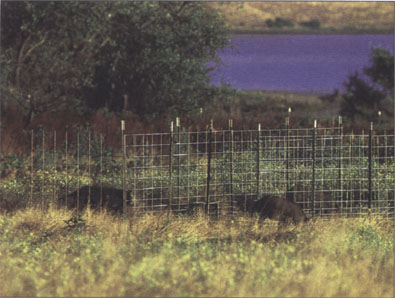All Issues
Research and reason can minimize foodborne and waterborne illnesses
Publication Information
California Agriculture 51(2):8-14. https://doi.org/10.3733/ca.v051n02p8
Published March 01, 1997
PDF | Citation | Permissions
Abstract
Several outbreaks of foodborne and waterborne illness have directed the nation's attention to intestinal pathogens that are threats to public health. Among these pathogens are Cryptosporidium parvum and Escherichia coli O157:H7, which are known to infect and to be spread by not only humans, but also livestock and various species of wildlife. New regulations aimed at controlling these pathogens are being implemented, despite a shortage of scientific information about their ecology, how they contaminate food and water supplies, and how to detect and eliminate such contamination. Research is needed to address these issues and to develop better technologies for pathogen detection, water treatment and food processing.
Full text
Undercooked hamburgers contaminated with E. Coli O157:H7 were responsible for a major outbreak of intestinal illness in 5 western states in 1993. Ground beef is unlike most other raw meats in that microbial contaminants are distributed throughout the product by grinding. Hamburger cooked rare or medium-rare can still contain viable organisms on the inside.
Recent outbreaks of foodborne and waterborne disease in the United States have heightened concerns about several specific pathogens and prompted actions by federal, state and local agencies that could have serious implications for agriculture. Two pathogens in particular — the protozoan Cryptosporidium parvum and the bacterium Escherichia coli O157:H7 — have caused major disease outbreaks in the past few years.
-
In April 1993, C. parvum contaminated the public water supply in Milwaukee, Wis., causing 403,000 cases of diarrhea and more than 100 deaths (MacKenzie et al. 1994). It was the largest outbreak of waterborne disease ever documented in the United States.
-
In January 1993, an outbreak of intestinal illness first detected in Washington state was traced to undercooked fast-food hamburgers contaminated with the bacterium E. coli O157:H7 (Bell et al. 1994). More than 700 people in five western states were made ill with bloody diarrhea or kidney failure, at least four died, and several survivors lost part or all of their large intestines or kidneys.
-
In October 1996, another outbreak of illness caused by E. coli O157:H7 was traced to fresh, unpasteurized apple juice. A total of 66 cases was reported from three states and British Columbia. One child died of kidney failure caused by the illness.
The 1993 outbreaks caused wide-spread public concern and prompted regulatory actions at federal, state and local levels. In 1996, the U.S. Department of Agriculture (USDA) announced a sweeping reform of federal food safety rules for meat and poultry, while the Environmental Protection Agency (EPA) issued new rules and amendments to the Safe Drinking Water Act.
Surveys indicate that Cryptosporidium oocysts are common in surface waters throughout North America, but the limitations of current tests make it difficult to learn where significant hazards lie. Although drinking water is treated, no test is available that can rapidly and sensitively detect C. parvum in treated water.
The new regulations call for, among other things, increased sampling and testing and improved control measures for foodborne and waterborne pathogens. On a local level, some public water districts are considering changes in watershed management. In some cases, owing to the level of public concern, regulatory action has preceded scientific understanding. Little is known about the medical ecology of these organisms, their sources, and how best to detect and control them. Several studies, funded in part by the UC Division of Agriculture and Natural Resources, are now under way to address these issues.
Common features
Both E. coli O157:H7 and C. parvum infect the intestines and are shed in feces. E. coli O157:H7 is a virulent strain of the harmless E. coli bacterium that normally inhabits the intestines of humans and other warm-blooded animals. This pathogenic strain is known to infect and to be shed by humans, cattle, sheep, deer and possibly other ruminants. C. parvum infects about 80 species of animals, including humans, cattle, sheep, goats, pigs, horses, dogs, cats and various wildlife species, such as deer, raccoons, opossums, pigs and rabbits. Both organisms have been found throughout the world, wherever researchers have looked for them.
These pathogens can spread in a variety of ways, but always through fecal matter. They may pass directly from host to host (e.g., among children in day-care centers or among young animals in a holding pen), as well as via fecally contaminated food and water. Although people usually defecate in toilets, if they don't wash their hands carefully afterward they may convey pathogens to food. Surface water can become contaminated from unintentional discharges of raw or inadequately treated sewage or from run-off of domestic and wild animal wastes.
In some outbreaks of foodborne or waterborne disease, the contamination has clearly had a human origin, such as a food handler with an intestinal infection or a swimmer shedding the pathogen into water. There have been cases of both cryptosporidiosis and E. coli O157:H7 infection acquired from swimming in lakes, and some cases of cryptosporidiosis have been linked to swimming pools.
The source of the contamination of Milwaukee's water supply, which is drawn from Lake Michigan, was never determined. Possible sources considered by investigators included cattle along two rivers that flow into the Milwaukee harbor, slaughterhouses, and human sewage (MacKenzie et al. 1994). Cattle have been implicated in several outbreaks of waterborne illness, but the evidence has seldom been conclusive. Although we know that both C. parvum and E. coli O157:H7 can be shed by mammalian sources other than humans and cattle, such sources are rarely explored during outbreak investigations. Several UC researchers and others are working to develop tests that would make it easier to trace the source of contamination in such outbreaks.
Foodborne disease outbreaks caused by E. coli O157:H7 and similar agents have been associated with contaminated ground beef, roast beef, dry Italian-style salami, raw milk, apple juice, cantaloupe, lettuce and other vegetables. Ground beef is the most commonly implicated vehicle of transmission in foodborne outbreaks of E. coli O157:H7 infection (Armstrong et al. 1996). Beef may become contaminated if intestinal contents contact the meat during slaughter or processing. Bacteria present on the surface of the meat are distributed throughout the meat by grinding.
Foodborne vs. waterborne: What's the difference?
Whether a pathogen is called foodborne or waterborne depends on its primary vehicle of transmission. E. coli O157:H7 is primarily foodborne — but people have been sickened by this microbe after swimming in contaminated lakes. Fewer than 50 E. coli O157:H7 bacteria can cause serious illness. Fortunately, this pathogen is destroyed by chlorine and so is usually not a problem in drinking water.
E. coli O157:H7 presents greater food risks than C. parvum. Specifically, E. coli O157:H7 can continue to multiply outside human or animal hosts, even on refrigerated meat. Cooking meat to an internal temperature of 155° F kills this pathogen.
The history of outbreaks suggests that C. parvum is a greater risk in drinking water than in food, largely because it is not killed by chlorine. It can be transmitted on food, but it does not proliferate outside human or animal hosts. Its oocysts remain dormant until ingested by a human or animal host. While as few as 30 oocysts can cause illness, it is self-limiting in healthy individuals, lasting for a few days to 2 weeks. However, it can be life-threatening to those with weakened immune systems.
It is not known how people typically become infected with Cryptosporidium. Drinking water was clearly the primary transmission vehicle in Milwaukee and in other major outbreaks of cryptosporidiosis. In general, however, the relative importance of various possible transmission routes is unclear. Food-related outbreaks have involved raw milk, possibly raw sausage, tripe, kefir and apple juice. During the Milwaukee outbreak, Cryptosporidium carried in tap water was suspected of contaminating salad dressings, dairy products and sausages, so the suspect foods were recalled.
Illness in humans
No drug is known to be effective in treating the infections and illnesses caused by these pathogens. E. coli O157:H7 and several other, less common strains of E. coli produce a toxin similar to Shiga toxin of Shigella dysenteriae and cause severe bloody diarrhea in humans. The infection can lead to kidney failure (hemolytic uremic syndrome) and death.
Shiga toxin-producing E. coli are notably more resistant to acid conditions (as in apple juice) than non-pathogenic strains of E. coli. E. coli O157:H7 can survive a pH as low as 2.0 under certain circumstances (Armstrong et al. 1996). The bacteria can multiply in foods and elsewhere in the environment under some conditions, as well as in the host's body. They can be killed by heat, chlorine or UV light. An internal temperature of 155°F during cooking is sufficient to kill more than 99% of organisms in ground beef (Bell et al. 1994).
The largest documented outbreak of foodborne illness caused by E. coli O157:H7 occurred in Japan in 1996, when more than 9,000 people became ill and at least 11 died. The source of the outbreak was never determined.
Cryptosporidium infection causes watery diarrhea associated with abdominal cramping, nausea, vomiting and fever. In people with normal resistance, cryptosporidiosis is a self-limiting illness from which most patients recover after a few days or weeks. Those with compromised immune systems, however, develop long-term infections and may die from the illness. People at greatest risk from cryptosporidiosis include organ transplant recipients, AIDS patients and some cancer patients.
Cryptosporidium is transmitted among hosts in the form of “oocysts,” which cannot multiply in foods or elsewhere in the environment. The oocysts are very resistant to chlorine but probably not to heat or UV light. Each oocyst contains four “sporozoites” that emerge and infect a new host's intestines after the oocyst is swallowed. There are several species of Cryptosporidium that infect animals, but only C. parvum is known to infect humans.
Studies indicate that very few viable cells of E. coli O157:H7 or oocysts of C. parvum need to be ingested with food or water to produce infection. For example, an infectious dose of 132 calf-derived oocysts caused cryptosporidial infections in 50% of healthy human volunteers (Dupont et al. 1995). The lowest infectious dose sufficient to induce cryptosporidiosis was 30 oocysts. In outbreaks of E. coli O157:H7 infection, the infectious dose has been estimated to be fewer than 50 bacteria and, in some cases, as few as 5 (Armstrong et al. 1996).
Regulatory actions
In response to the 1993 disease outbreak caused by E. coli O157:H7 in fast-food hamburgers, the Clinton administration mandated safe-handling labels for raw meat and poultry products, declared E. coli O157:H7 an adulterant in raw ground beef (making the sale of contaminated meat unlawful) and initiated a testing program for that pathogen. Ground beef is unlike most other raw meats in that microbial contaminants are distributed throughout the product by grinding, rather than being concentrated on the surface. As a result, a hamburger cooked rare or medium-rare (as preferred by about one-fourth of the U.S. population) still contains viable organisms on the inside. This is a particular concern given the extremely low infectious dose of E. coli O157:H7.
The 1993 outbreak also set in motion a major revision of the USDA's food safety program, culminating in the 1996 reforms known as the “Final Rule on Pathogen Reduction and Hazard Analysis and Critical Control Point (HACCP) Systems” (USDA 1996). The new regulations require all slaughter and processing plants to implement HACCP plans. The HACCP (pronounced “hassip”) concept originated in the space program to ensure food safety for astronauts. It requires food processors to identify “critical control points” where hazards such as microbial contamination can occur, establish controls to prevent or reduce those hazards, and maintain good records.
Cryptosporidium sporozoites infect a host's intestines, causing watery diarrhea, abdominal cramping, nausea, vomiting and fever.
Wildlife, including black-tailed deer, may be significant sources of cryptosporidial contamination of surface water.
In addition, the new rules require slaughter plants to conduct microbial testing of carcasses for generic E. coli to verify that their procedures are working to prevent fecal contamination. New performance standards for Salmonella require slaughter plants and producers of raw ground meat to ensure that their Salmonella contamination rates are below the current national baseline. And finally, all plants must adopt standard operating procedures for sanitation.
Similarly sweeping reforms of the EPA's drinking water regulations were at least partly inspired by the Milwaukee outbreak of cryptosporidiosis. Under proposed changes to the Surface Water Treatment Rule, public water systems that use surface water sources may be required to treat specifically for Cryptosporidium (EPA 1994).
Cryptosporidium oocysts are resistant to chlorine and may not be eliminated by disinfection procedures designed to remove other protozoan pathogens, such as Giardia. Even a well-run water-treatment system cannot ensure that drinking water will be completely free of the parasite. Because no available test can rapidly and sensitively detect Cryptosporidium in treated water, water-treatment plants can only monitor water-quality indicators such as turbidity and try to maintain a level of water quality (through filtering and other procedures) that makes the presence of oocysts unlikely (MacKenzie et al. 1994). The EPA may require some water systems using unfiltered surface water to implement filtration procedures.
The EPA has acknowledged that numerous scientific uncertainties must be resolved before it can establish specific safety standards for Cryptosporidium. To gather data needed to resolve these issues and guide the agency's modifications of current regulations, the EPA promulgated the 1996 Information Collection Rule (ICR). Among other things, the ICR requires large, public water systems to collect information on the presence and levels of microbial contamination (including Cryptosporidium) and the effectiveness of various treatment technologies. Unfortunately, available tests for Cryptosporidium may not produce meaningful data. The reagent used in the immunofluorescent assay to detect C. parvum cross-reacts with other species of Cryptosporidium that are not infectious to humans. In addition, the tests are unable to distinguish between viable oocysts and dead ones. To address these problems, the EPA is undertaking supplemental surveys using more sophisticated analyses.
While the EPA is making an effort to gather data before establishing new regulations, other agencies have been less inhibited by the lack of scientific information. For example, the San Francisco Water District is considering a ban on cattle grazing within its watersheds. Alternatively, the water district may continue to allow grazing while requiring new management practices designed to guard against Cryptosporidium and other waterborne pathogens. The final decision, which is expected in May, will affect 15 ranchers who graze 1,990 cattle on city-owned land surrounding two reservoirs in Alameda County.
Studies have not shown a clear link, however, between cattle grazing, and the presence of C. parvum oocysts in surface water. Cryptosporidium oocysts are common in surface waters throughout the United States, but the limitations of available testing procedures make it difficult to determine where significant hazards exist.
Prevalence in animals
In California beef cattle, clinical cryptosporidiosis and shedding of C. parvum are usually limited to calves up to 4 months of age. Older calves and adult cattle do not appear to shed appreciable amounts of C. parvum in their manure. In selected populations, such as dairy calves, clinical cryptosporidiosis and shedding of C. parvum occur primarily within the first month of life. In contrast, humans and several species of wild animals can be infected and shed C. parvum at all ages. Consequently, if we were to find that on a specific watershed beef calves were a significant source of viable C. parvum, the risk of contamination could be greatly reduced if ranchers prevented young calves from grazing near water or if they grazed older animals.
Wildlife may be significant sources of cryptosporidial contamination of surface water. In a survey of 100 raccoons, 13 juveniles had oocysts in their feces (Snyder 1988). Cryptosporidial infection has been confirmed in gray squirrels and mule deer. Thirty percent (35/115) of wild mice trapped at a dairy shed oocysts (Klesius et al. 1986). Sixty-three percent of wild brown rats have been found to shed C. parvum (Webster and McDonald 1995). In surveys we have conducted, 5% of feral pigs trapped in coastal California were found to be shedding what we believe are C. parvum oocysts.
E. coli O157:H7 infection is also more common in calves than in older cattle. Estimates of the prevalence of shedding among cattle range from 0 to 4%, with adults at the lower end and calves at the upper end of this range. E. coli O157:H7 has a wide geographic distribution in the United States, occurring in 63% of feedlots in one large survey (Armstrong et al. 1996). Relatively few studies have looked at its prevalence in other animals. A survey of a single flock of 35 sheep in Idaho found that the prevalence of shedding ranged from 0 to 31%, depending on the season. In Texas, researchers found that 2 out of 108 deer were shedding the bacterium.
The fate and distribution of manure from cattle and other livestock, and its potential to contaminate food and water depend on the type of livestock operation. In cow-calf operations, rangeland sheep herding and other “extensive” livestock operations, manure is left where it falls. In intensive operations, such as feedlots and dairies, manure may be composted for use as bedding or it may be applied to agricultural land as fertilizer.
Although composting is likely to kill any pathogens, uncomposted manure that is applied to land where crops are grown for human consumption or that enters surface waters destined for human water supplies may contain pathogens. C. parvum cannot multiply outside the host and may be killed by heat, drying, freezing or UV light, but not by chlorine. C. coli O157:H7, on the other hand, may multiply in the environment under some conditions, but can be killed by chlorine as well as by heat or UV light.
Pressure on agriculture
Consumer and regulatory concerns about food and water safety are gradually being directed toward production agriculture. There is increasing pressure to impose on-farm measures that will eliminate pathogens so that processors and consumers do not have to worry about them. Although the current focus of USDA regulations is on slaughter and processing plants, the agency is also considering a comprehensive food-safety strategy that addresses hazards at other points “from farm to table.” This could eventually put the onus on farmers to eliminate pathogens from their herds, even though the means to do so may not be available.
When outbreaks of foodborne illness occur, regulatory efforts are often directed upstream, beginning with the distributor, leading back to the processor and, if possible, finally reaching the original producer. Pathogens can contaminate food products anywhere along the line from producer to consumer. In many cases, the contamination occurs at centralized processing facilities or from improper handling by consumers. For instance, foodborne bacterial pathogens can multiply from a harmless level to one high enough to cause illness in humans if the product is not refrigerated or is otherwise improperly handled.
If established management practices can eliminate a pathogen at the production level, there may be justification for holding producers responsible for its presence. However, there are many emerging foodborne pathogens about which we know almost nothing. In the case of E. coli O157:H7, for example, we have very little information about how the bacterium is introduced into a dairy or cow-calf operation or why it often appears to suddenly leave the herd.
While it is entirely reasonable that we expect food to be safe and wholesome, some consumers and public officials have expressed zero tolerance for risk. It will be extremely difficult, if not impossible, to implement public policy that will satisfy them. Society's growing detachment from how food is raised results in the unreasonable expectation that farms or ranches can be run as microbe-free, sterile environments. We often can raise and grow food with a minimum of pathogenic microorganisms on the product, but it is not a sterile commodity.
Both C. parvum and E. coli O157:H7 can be killed in food by irradiation, although this is not a widespread practice. The U.S. Food and Drug Administration does not permit irradiation of red meats.
The most generally applicable means of decontaminating foods is with heat, by pasteurization or cooking. Consumers must use proper food preparation and cooking practices to minimize foodborne disease. At the same time, producers and processors should adopt management practices that minimize the levels of pathogens present on the product. However, agriculture can only adopt such practices once they have been identified through research. Moreover, we know very little about the ecology of foodborne pathogens at the farm level.
Research in progress
Research is under way — in part funded by the UC Division of Agriculture and Natural Resources — to estimate the prevalence and to identify risk factors for shedding of a variety of possible foodborne bacterial and protozoal pathogens in livestock populations. If, for instance, we find that beef calves being produced by California's 700,000 to 950,000 beef cows are not significantly infected by major foodborne pathogens, then devising management practices that focus on cow-calf production will likely have little impact on reducing the incidence of foodborne illness associated with beef products. If, on the other hand, calves coming off of California's rangeland are an important entry point for a foodborne pathogen, then through research, extension and working closely with the industry we can develop management plans that minimize risk of foodborne disease.
Preliminary data suggest that less than 1% of rangeland beef calves are shedding E. coli O157:H7 and an equally low proportion of calves are shedding C. parvum at time of weaning, 6 to 9 months of age. A more sensitive test for detecting E. coli O157:H7 probably would have found more infected cattle. What we cannot say at this time is whether these low prevalences of shedding pose a risk to the consumer and what is the relative importance of animal shedding postweaning, during stock operations, in the feedlot, or at the time of slaughter. How meat products are handled and refrigerated after slaughter directly affects the numbers of bacteria present on the finished product and may completely nullify any preharvest efforts directed at food safety.
It is not known whether most of the E. coli O157:H7 that occasionally contaminates beef carcass surfaces comes from the animal's intestines or from the hide. Much research — being conducted at several universities, including UC Davis, and USDA — is currently aimed at identifying critical control points at slaughter to decontaminate the surface of a carcass. Most methods being tested are based on washing the carcass surface with water or solutions containing organic acids, hypochlorous acid, hydrogen peroxide, or trisodium phosphate. Although several of these methods look promising, there is some doubt that any will guarantee the absence of pathogenic E. coli, generic E. coli, or Salmonella.
With respect to dairy cows and milk production, we find very few cows shedding C. parvum in their manure, but we cannot explain why we find C. parvum in the flush water coming from the wash pen for lactating cattle, nor can we say what level of shedding results in an appreciable risk of milkborne transmission. Does the widespread occurrence of C. parvum infection in dairy calves pose any risk to the veal market or to lactating cattle? The answers to these critical questions will show where on-farm or on-ranch problems exist — and just as important, where they do not exist. Only then can we devise effective solutions.
We and other researchers are also working to develop new detection methods for pathogens such as C. parvum. Better tests will help clarify where actual risks exist, allow us to evaluate different water-treatment and food-processing methods for inactivating pathogens, and help prevent false alarms resulting from detection of pathogens that are already dead because of food processing practices or other mechanisms. Finally, a group of UC researchers is taking a multidisciplinary approach to understand how oocysts travel through a watershed from land to water.
Research, education needed
Recent outbreaks of foodborne infectious disease caused by E. coli O157:H7 and C. parvum have gotten the public's attention. Food safety solutions will come only with a detailed understanding of how and why pathogens enter the food supply; better detection and processing technologies; working cooperatively with producers, processors and distributors; and educating consumers through such means as UC Cooperative Extension on how to prepare and cook their food properly and safely.



